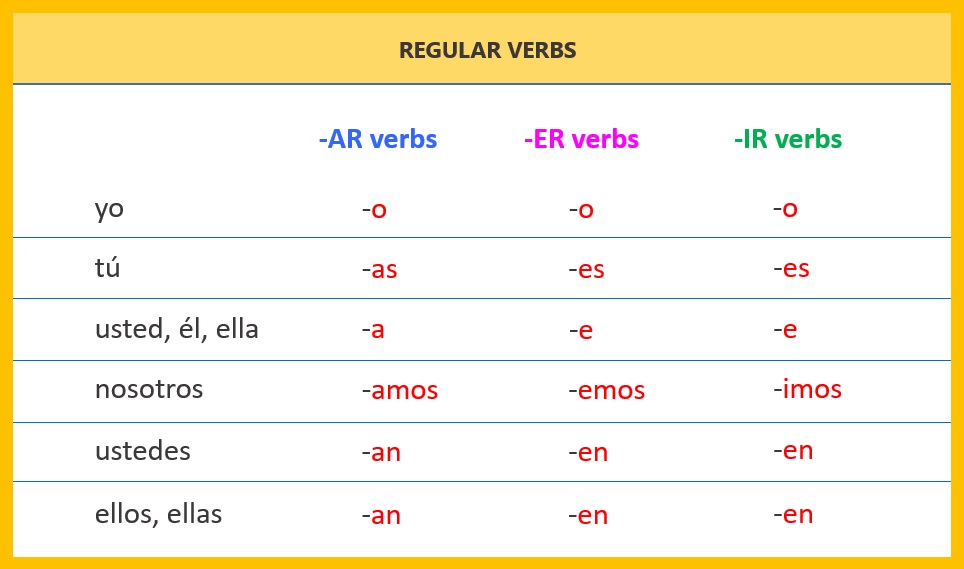

Try us out for free today.If you’re about to or currently learning Spanish, eventually you’ll hear about ‘-AR’ verbs. We’re Busuu, the app home to a community of over 120 million learners. Mis amigos _ un accidente la semana pasada.Juan y yo no _ el fin de semana pasado.We know, memorising verb endings is certainly not the most exciting part of learning Spanish.īut think of it this way – once you’ve learned them, you’ll be able to start having great conversations and really express yourself in Spanish!Ī little bit of practice is all it takes! Test yourselfĭo you want to put all your newly acquired conjugation knowledge into practice? Take our quiz and see how you go! That can only mean one thing: less conjugations to learn! Final words of advice on preterite endings Both ser and ir have exactly the same forms in the preterite tense. Let’s carry on with two of the most common irregular verbs in the preterite tense. For example, you only have to learn estar, and then remove the first two letters “es” and you’ll know the verb tener. ( María did the shopping.)Īnd to make things even easier, estar and tener have very similar forms. It becomes hizo (he / she / you formal did) *The verb hacer changes the c for a z in the third person singular. So you won’t have to memorise lots of different sets of endings for each verb. The best thing about all these verbs is that they share the same endings. And we’ll give you a few tips to help you learn their conjugation. Instead, we are just going to focus on a few sneaky irregular verbs that you will use the most. We are not going to learn a never-ending list of irregular forms. While regular verbs are pretty simple, the preterite tense does have a large number of irregular conjugations.īut don’t give up just yet. Keen to learn Spanish for an upcoming trip? Try Busuu’s dedicated Spanish for travel course. Ustedes is only used in formal situations.īut in all Latin American countries, as well as in the Canary Islands, ustedes is always used to address a group of people, whether it’s a formal or an informal situation. Remember, Spain is the only Spanish speaking country where you use vosotros / vosotras to address a group of people informally. Preterite: Cenamos fuera ayer por la noche. We usually go out for dinner on Friday nights. Present: Normalmente cenamos fuera los viernes por la noche. But the context will always help you figure out if it refers to the past or the present. The endings for nosotros in the -ar and -ir verbs are the same in the preterite and in the present tense. They ate / they lived you all ate / you all lived (formal) The pronunciation in Spanish is also quite different, with more emphasis on the last syllable in trabajó.ĭon’t forget that the written accent will change the tense and even the person performing the action! Preterite verbs ending in -er and -ir Person Worth noting: The third person singular form ( él, ella, usted) for -ar verbs looks almost identical to the first person form ( yo) in the present tense, except for the accent above the ‘o’. Less conjugations to memorise – that’s a win! Preterite verbs ending in -ar Person The good news is there are only two sets of endings for regular preterite verbs: one for – ar verbs and another one for – er and – ir verbs. How many sets of regular preterite endings are there? add the preterite ending, according to who’s performing the action.drop the infinitive ending, – ar, – er or – ir.

#Spanish verb endings for mi amigos how to#
Regular preterite verb endings How to conjugate the preterite tense So let’s take a look at how to conjugate verbs in the preterite. Verb endings not only tell you when the action occurs, but it will also give you a better idea of who is performing the action. It’s used in the same way as the ‘Simple Past’ in English.Īnd because it’s fairly easy to understand, it’s just a matter of learning the preterite endings and you’ll be on your way! The preterite is a great one to start with as it’s used to talk about past events that have been completed – such as what you got up to on the weekend or on holiday. With five different past tenses in Spanish, the idea of learning them all can be daunting! That’s why we recommend starting with the most commonly used tense – the preterite ( pretérito indefinido). Once you’ve learned the basics of verb conjugation in the present tense, you’ll quickly realise that the next important grammar step is conjugating verbs in the past tense.Īfter all, trying to describe your weekend without knowing the Spanish past tense endings is practically impossible! The preterite is probably the first Spanish past tense you’ll learn, as it’s used to talk about past events which have been completed.


 0 kommentar(er)
0 kommentar(er)
